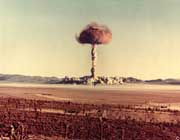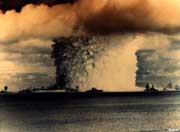|
 Sandia,
NM -- In New Mexico's desert and Russia's Ural Mountains,
U.S. and Russian experts are experimenting with simulated
"dirty bombs" to see how such radiation weapons
and potential terrorist tools might work, officials of
the two countries said. Sandia,
NM -- In New Mexico's desert and Russia's Ural Mountains,
U.S. and Russian experts are experimenting with simulated
"dirty bombs" to see how such radiation weapons
and potential terrorist tools might work, officials of
the two countries said.
It's a sensitive area in which some information
is withheld to keep clues to bomb-building out of terrorists'
hands. But American and Russian specialists attending
a global conference on dirty bombs disclosed some aspects
of recent testing to a reporter because, as a ranking
U.S. official said, the public should know everything
is being done to deal with the threat.
These so-called "RDDs," for
radiological dispersal devices, haven't made an appearance
yet, but the al-Qaida terrorist network, for one, is reported
to have developed several of them.
"One could go off in a major city
any day," says Raymond Mosack, Battalion Chief of
the Los Angeles County Emergency Network System.
Dirty bombs would combine conventional
explosives with strontium, plutonium, cesium or some other
highly radioactive isotope used for such purposes as cancer
radiotherapy, military research, searching for oil deposits
and sterilizing food.
They wouldn't cause the immediate mass
casualties or devastation of nuclear weapons, but they
are much simpler to make and the contamination and fear
of radiation poisoning could cause general panic and shut
down core sections of cities for years.
"There are over 600 kilograms of
plutonium not accounted for in the former Soviet Union,"
says Lt. Col. Stanislav Lunev, a former Russian KGB agent
who has testified to the U.S. Congress. "And there
are more than 50 remote, pre-placed atomic demolition
devices inside U.S. borders near hydro-electric dams and
nuclear electrical facilities."
U.S. officials downplay such warnings,
saying that dams and nuclear power stations are routinely
scanned for unusual localized radiation levels. Others,
meanwhile, are trying to learn how a dirty bomb would
behave if detonated.
 For
the past six months, teams at the U.S. Energy Department's
Sandia National Laboratories in New Mexico have been experimenting
with basic designs of RDDs, said the U.S. official, who
spoke on condition of anonymity. Using materials that
simulate the characteristics of the radioisotopes -- except
for the radioactivity -- they have been exploding the
devices to test the reach of the radiation effect as a
result of blast and wind, he said. For
the past six months, teams at the U.S. Energy Department's
Sandia National Laboratories in New Mexico have been experimenting
with basic designs of RDDs, said the U.S. official, who
spoke on condition of anonymity. Using materials that
simulate the characteristics of the radioisotopes -- except
for the radioactivity -- they have been exploding the
devices to test the reach of the radiation effect as a
result of blast and wind, he said.
With a minimum of 1kg of readily-available
commercial powder, they found that they could force the
evacuation of a major U.S. city, with immediate casualties
of 30,000 people and up to 80,000 casualties after three
days. Further computer modeling allowed the testers to
assess likely levels of radiation in various areas as
a result of the blasts and determined that an area of
25 square miles would have to be abandoned for up to 5
years.
Formal results from the U.S. Defense Department
tests haven't reached Washington yet. But researchers
already know some things, such as that cesium chloride
powder, used in large amounts in food irradiators and
some older medical devices, is probably the material best
suited for dirty bombs.
"It's very radioactive, and the powder
disperses well," the official said.
He said the tests will be stepped up to
the level of radiothermal generators -- devices packed
with large amounts of isotopes, developed by the Soviet
Union and the United States during the Cold War to power
long-life aviation beacons and other remotely installed
military equipment.
Such generators often hold 40,000 curies
-- the basic measure of radioactivity -- in strontium
or other material. Experts say even 1,000 curies might
make an effective dirty bomb.
"A Russian admiral told us there
have been many attempted thefts of RTGs reported,"
the U.S. official said, adding that apparently none was
successful.
A Russian scientist, Alexander M. Agapov,
told the Vienna conference it's possible 900 such devices
were deployed by the old Soviet military, many with radio
beacons or small lighthouses along Russia's Arctic fringe.
Retrieving and securing that radioactive material will
be a major challenge.
In his slide presentation, Agapov, safety
chief for Moscow's Atomic Energy Ministry, described Russian
computer simulations of dirty-bomb events. In a sign of
the sensitivity, however, he blocked out the amounts of
TNT and radioisotope used for simulated weapons.
He later told a reporter the Russians
determined that radioactive particles from an explosion
do not disperse in an oval pattern following wind direction,
as usually theorized, but in a much more irregular pattern
affected by crosscurrents.
Agapov described a Ural Mountains field
test of emergency response, based on a computer simulation
of a terrorist bazooka attack on a train carrying cobalt-60
and cesium-137, isotopes common in Russian transport.
The test didn't involve an actual attack, but a small
amount of isotope was used and controlled fires were set
beside a train car, to test detection abilities and response.
He said the conclusion was that people
within a mile or two of the attack would have to be evacuated
within five to six minutes -- or at least kept sealed
indoors. "You don't have time to check wind direction.
You just move," Agapov said.
|